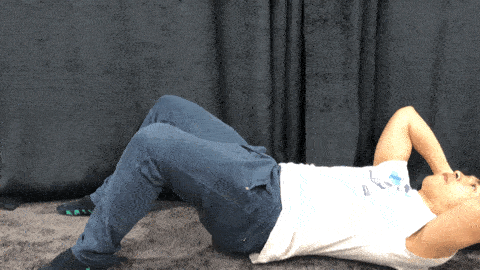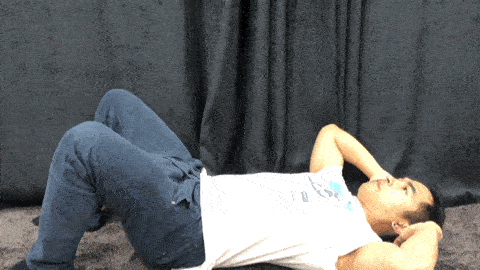
The best online fitness resource you'll ever need. We filter out the BS to ensure you meet your health and fitness goals!

The best online fitness resource you'll ever need. We filter out the BS to ensure you meet your health and fitness goals!

For many, six-pack abs are the holy grail of physique training. Top athletes and celebrities often show off their toned midriffs to rapturous adulation, and there’s nothing like a taut stomach to give you confidence on the beach.
However, for as long as we’ve had a love for abs, we’ve had a lot of argumentation over how best to achieve six-packs, those most elusive of prizes. Most people, in ignorance or not, fall back on a couple of exercises when looking to strengthen their cores and achieve a six-pack: sit-ups and crunches.
But which is better, and does either really work? Let’s break it down, delving into what the science says about these two staple exercises.
To perform a safe, effective sit-up:

You will want your base setup for the crunch to be like the sit-up:

The first port-of-call ab-exercise for many is the sit-up. It’s versatile, needs no equipment, and works multiple muscle groups in and around your core. As well as you outer abdominal muscles (the ones that pop in a perfect six-pack), sit-ups work your rectus abdominus (the deeper tissue beneath your abs) hip flexors, lower back, and to a certain extent your legs.
The strength and added muscle that sit-ups can grant will give you several benefits. First, muscle tissue is very metabolically active- far more so than fat cells. Having greater muscle mass will therefore raise your basal metabolic rate (BMR), allowing you to burn more calories throughout the day. If you’re looking to lose fat, this is ideal. In addition, the strength around your middle will improve your posture, preventing many injuries and adding to the aesthetically pleasing nature of your physique.
However, many dislike sit-ups and they have seen a loss in popularity in recent years. This is partly due to the lack of specificity and the fact that, without perfect technique (which few possess), they actually do very little for your abs themselves. It’s also because of the propensity for injury that comes with performing sit-ups. Lower back and neck injuries can be commonplace, and it’s always advisable to seek out professional advice before beginning them.
Crunches are an alternative to the sit-up that focus on muscle isolation, using far fewer muscles far more intensively. They only work the abdominal muscles, with a little support from surrounding muscle, and so are more efficient at building lean abdominal muscle mass.
Crunches are great for those looking to get six-pack abs, as the hypertrophy they elicit will give you a solid, blocky set of core muscles with clear definition. They are also good for strengthening your core, leaving other muscles behind so that you can zero in on the ones you’re looking to train.
Much like sit-ups, this core strength will have numerous health and aesthetic benefits, including good posture and improved overall strength. Crunches are also considered to be safer than sit-ups, with much less strain placed on the lower back and neck.
Just as sit-ups’ generality is a downfall, however, so too can crunches’ specificity be considered one. The immediate benefits are just to the core. Whilst it’s always good to have a strong core, everyday movements are not isolated, and so there is limited practical or athletic carry-over from performing crunches.
You may think that sit-ups and crunches look pretty similar, and that they elicit similar results. This is partly true. You start form the same position and work similar motions, putting the emphasis on drawing strength and contraction from your abs. However, there are some fundamental differences that I’ve already hinted at which set the two apart.
Muscle recruitment is one of the primary differences here. As mentioned above, crunches isolate your abs in a way that sit-ups can’t. The sit-up involves raising your entire torso from the ground, requiring more total core control alongside hip flexor and quadricep engagement. Many people report aching upper legs when they begin sit-ups, rather than sore abs. This is because the often-underworked rectus femoris (in your quads) is taking so much of the pressure. More muscle may sound good, but it makes for a less effective core-specific workout.
Spinal impact and back health are also a concern, briefly noted above. All exercises bring a certain risk with them, and all have a certain reward: how they balance the risk vs reward is vital in choosing which ones to perform. Overhead presses are arguably very risky, for instance, as you’re lifting very heavy weights directly above your head. However, they do so much for your full-body, specifically upper-body, strength that they have a very positive reward to risk ratio.
Sit-ups do not. It’s hard to perform them without hurting your lower back, rounding it and placing undue stress through your spinal column. Add this to what many consider to be a relatively low reward for your abs, and you have a quite poor exercise.
Whilst the crunch can also bear these failings, it is much easier to perform them with correct, safe posture. You can keep your lumber spine unflexed and avoid any unnecessary stress and risk. Though many consider the reward still quite low, the risk is also low: it works out well enough.
Not really, no. They may strengthen your core, especially crunches, but you will often hear it said that abs are made in the kitchen, not the gym. Neither sit-ups nor crunches give you much of a caloric burn (there is little difference between either in this regard.) For this, you will need a correct diet (see below) and a more holistic approach to training in order to burn fat, working large, full body movements that are more metabolically and aerobically demanding.
It’s always advisable to look for core variations that are both more efficient at raising your heart rate and more effective at strengthening your abs. Sit-ups and crunches plateau quickly, giving you little by way of progressive overload. Some popular, hard core-intensive exercises include:
As these all use resistance above and beyond mere bodyweight, they can all be made harder as your body adapts. Many core protocols forego crunches and sit-ups entirely, focussing instead on movements like these.
Finally, fix your diet. You need to lose weight to reveal your abs.
Typically, abs will be visible in the low teens to single digit bodyfat percentages. Above this, it doesn’t matter how much you build up your core strength: from an aesthetic point of view, it’s wasted time until you shift the fat.
You also can never burn belly fat in isolation: this is a myth that is thankfully disappearing in most circles. Muscle growth can be spot targeted, but fat can only be lost universally. Whether you have belly fat will depend on two things: your overall bodyfat percentage and where your genetic disposition is to hold onto fat. If you retain fat around your midriff, you’ll find it harder to achieve a six pack than someone who holds fat around their thighs and hips, for example.
The quickest, most efficient way to get your bodyfat percentage down is through a caloric deficit coupled with training. A 500-calorie daily deficit (roughly a quarter of the average diet) will result in the loss of 0.5kg per week.
Do this consistently, losing kilo after kilo, whilst doing the above core variations. Then you’ll have the six-pack abs that you want.